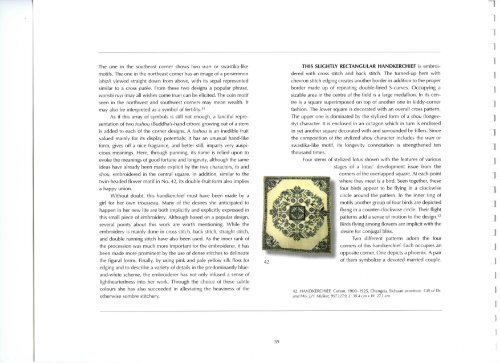Touched by Indigo - Royal Ontario Museum
Touched by Indigo - Royal Ontario Museum
Touched by Indigo - Royal Ontario Museum
You also want an ePaper? Increase the reach of your titles
YUMPU automatically turns print PDFs into web optimized ePapers that Google loves.
!<br />
The one in the southeast corner shows two wan or swastika-like<br />
motifs. The one in the northeast corner has an image of a persimmon<br />
(shizi) viewed straight down from above, with its sepal represented<br />
similar to a cross patee. From these two designs a popular phrase,<br />
wanshi ruyi (may all wishes come true) can be elicited. The coin motif<br />
seen in the northwest and southwest corners may mean wealth. It<br />
may also be interpreted as a symbol of fertility.31<br />
As if this array of symbols is still not enough, a fanciful representation<br />
of two foshou (Buddha's-hand citron) growing out of a stem<br />
is added to each of the corner designs. A foshou is an inedible fruit<br />
valued mainly for its display potentials: it has an unusual hand-like<br />
form, gives off a nice fragrance, and better still, imparts very auspicious<br />
meanings. Here, through punning, its name is relied upon to<br />
evoke the meanings of good fortune and longevity, although the same<br />
ideas have already been made explicit <strong>by</strong> the two characters, fu and<br />
shou, embroidered in the central square. In addition, similar to the<br />
twin-headed flower motif in No. 42, its double-fruit form also implies<br />
a happy union.<br />
Without doubt, this handkerchief must have been made <strong>by</strong> a<br />
girl for her own trousseau. Many of the desires she anticipated to<br />
happen in her new life are both implicitly and explicitly expressed in<br />
this small piece of embroidery. Although based on a popular design,<br />
several points about this work are worth mentioning. While the<br />
embroidery is mainly done in cross stitch, back stitch, straight stitch,<br />
and double running stitch have also been used. As the inner rank of<br />
the procession was much more important for the embroiderer, it has<br />
been made more prominent <strong>by</strong> the use of dense stitches to delineate<br />
the figural forms. Finally, <strong>by</strong> using pink and pale yellow silk floss for<br />
edging and to describe a variety of details in the predominantly blueand-white<br />
scheme, the embroiderer has not only infused a sense of<br />
lightheartedness into her work. Through the choice of these subtle<br />
colours she has also succeeded in alleviating the heaviness of the<br />
otherwise sombre stitchery.<br />
42<br />
THIS SLIGHTLY RECTANGULAR HANDKERCHIEF is embroidered<br />
with cross stitch and back stitch. The turned-up hem with<br />
chevron stitch edging creates another border in addition to the proper<br />
border made up of repeating double-lined S-curves. Occupying a<br />
sizable area in the centre of the field is a large medallion. In its centre<br />
is a square superimposed on top of another one in kiddy-corner<br />
fashion. The lower square is decorated with an overall cross pattern.<br />
The upper one is dominated <strong>by</strong> the stylized form of a shou (longevity)<br />
character. It is enclosed in an octagon which in turn is enclosed<br />
in yet another square decorated with and surrounded <strong>by</strong> fillers. Since<br />
the composition of the stylized shou character includes the wan or<br />
swastika-like motif, its longevity connotation is strengthened ten<br />
thousand times.<br />
Four stems of stylized lotus shown with the features of various<br />
stages of a lotus' development issue from the<br />
corners of the overlapped square. At each point<br />
where they meet is a bird. Seen together, these<br />
four birds appear to be flying in a clockwise<br />
circle around the pattern. In the inner ring of<br />
motifs another group of four birds are depicted<br />
flying in a counter-clockwise circle. Their flight<br />
patterns add a sense of motion to the design.32<br />
Birds flying among flowers are implicit with the<br />
desire for conjugal bliss.<br />
Two different patterns adorn the four<br />
corners of this handkerchief. Each occupies an<br />
opposite corner. One depicts a phoenix. A pair<br />
of them symbolize a devoted married couple.<br />
42. HANDKERCHIEF, Cotton, 1900-1925, Chengdu, Sichuan province, Oft of Dr.<br />
and Mrs. J.H. Mul/ett, 997.127.9, L. 30.4 cm x W. 27.1 cm<br />
S9
















